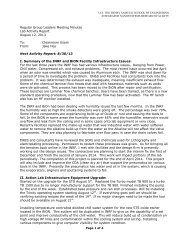Download Lab Safety Manual - Integrated Nanosystems Research ...
Download Lab Safety Manual - Integrated Nanosystems Research ...
Download Lab Safety Manual - Integrated Nanosystems Research ...
You also want an ePaper? Increase the reach of your titles
YUMPU automatically turns print PDFs into web optimized ePapers that Google loves.
First Aid • Move victim to fresh air<br />
• Remove contaminated clothing<br />
• In case of contact, flush skin or eyes with water<br />
• Keep victim quiet and warm<br />
• If not breathing give artificial respiration<br />
Common Solvents:<br />
Acetaldehyde<br />
Acetone<br />
Acetyl Chloride<br />
Allyl Alcohol*<br />
Allyl Chloride<br />
N-Amyl Acetate<br />
N-Amyl Alcohol<br />
Benzene*<br />
N-Butyl Acetate<br />
N-Butyl Alcohol*<br />
N-Butylamine*<br />
Carbon Disulfide*<br />
Chlorobenzene<br />
Cyclohexane<br />
Diethylamine*<br />
Diethyl Carbonate<br />
p-Dioxane*<br />
Ethanol<br />
Ethyl Acetate<br />
Ethyl Acrylate<br />
Ethylamine*<br />
Ethyl Benzene<br />
Ethylene Dichloride<br />
Ethyl Ether<br />
Ethyl Formate<br />
Furan<br />
Gasoline<br />
Heptane<br />
Hexane*<br />
Hydrazine*<br />
Isobutyl Alcohol<br />
Isopropyl Acetate<br />
Isopropyl Alcohol<br />
Isopropyl Ether<br />
Mesityl Oxide<br />
Methanol*<br />
Methyl Acetate<br />
Methyl Acrylate*<br />
Methylal<br />
Methyl Butyl Ketone*<br />
Methyl Ethyl Ketone<br />
Methyl Formate<br />
Methyl Isobutyl Ketone<br />
Methyl Methacrylate<br />
Methyl Propryl Ketone<br />
Morpholine*<br />
Napthalene*<br />
Nitromethane†<br />
Octane<br />
Piperidine<br />
Propanol*<br />
Propylene Oxide<br />
Pyridine<br />
Styrene<br />
Tetrahydrofuran<br />
Toluene*<br />
Turpentine<br />
Vinyl Acetate<br />
Xylene<br />
* Readily absorbed through the skin.<br />
†Most nitrohydrocarbons are flammable.<br />
V. OXIDIZERS<br />
Characteristics<br />
Storage<br />
Precautions<br />
Potential<br />
Hazards<br />
Contains available oxygen that can make ignition easier or cause a fire to burn with<br />
intensity.<br />
• Store in a cool, dry place, well-ventilated location in original containers.<br />
• Keep away from flammable and combustible materials (such as paper, wood, etc.)<br />
• Keep away from reducing agents such as zinc, alkaline metals, and formic acid.<br />
Fire/Explosion • Chlorites, chlorates, and perchlorates are potentially explosive in<br />
contact with combustibles, sulfur organic materials, metal<br />
powders.<br />
• Can explode if subjected to shock, friction, or heat.<br />
43



